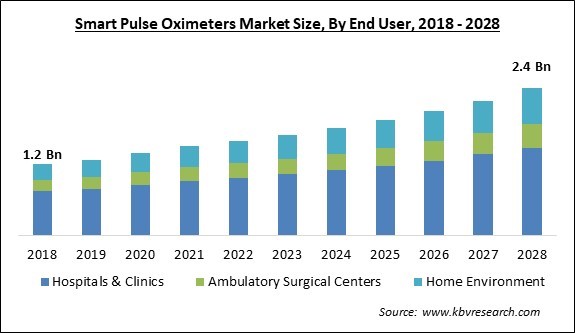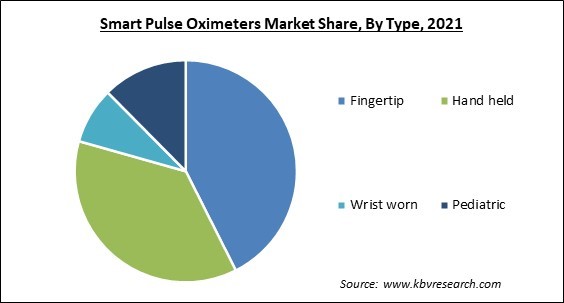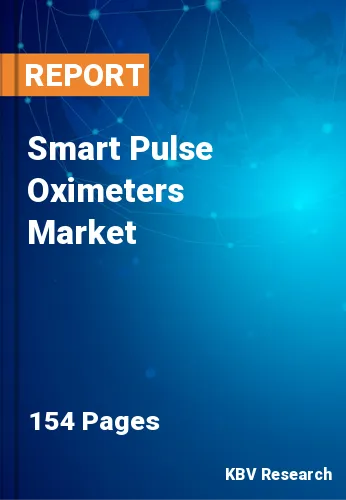The Global Smart Pulse Oximeters Market size is expected to reach $2.4 billion by 2028, rising at a market growth of 7.6% CAGR during the forecast period.
A cold light source is made to shine through the fingertip by a pulse oximeter, causing the tip to appear red. The device calculates the proportion of oxygen in the red blood cell by examining the light from the light source that travels through the finger. The pulse oximeter takes a quick reading of the body's oxygen saturation level without the use of needles or a blood sample. The detected amount on the screen represents the oxygen saturation of the red blood cells. This number informs doctors and nurses about the course of treatment.

The oxygen level may also be used to determine whether the patient requires additional oxygen. This saturation level (a good number would be over 90-92 percent) is different from the pO2 value (a good number would be over 60-65 percent), which is determined by drawing blood from an artery. The doctor can explain the relevance of the worth in relation to the condition.
If done correctly, one can expect a straightforward, quick, and safe measurement of their body's oxygen saturation level. The probe will be positioned, and the oximeter will produce a reading of the heart rate and oxygen saturation level within a few seconds, as shown in the image above. In oximetry measurement, there are no needles and no pain. Disposable tape probes that wrap around the finger, nose, or toe are also used in some hospitals.
Smart health applications are still a developing market, requiring high performance, low power, and high integration in a variety of medical solutions. A pulse oximeter is a small electronic device that detects a person's oxygen saturation level or the amount of oxygen in their blood. It is a vital gadget for monitoring the health of people who have any ailment that can alter their blood oxygen levels.
With the commencement of the COVID-19 pandemic, at-home pulse oximeters became popular as a way to track prospective symptoms. Because the virus frequently targets the lungs and the cardiovascular system, anyone infected is likely to have shortness of breath or difficulty breathing.
With a pulse oximeter, physicians can keep a careful eye on someone's condition and see when their oxygen levels start to drop dangerously low. The device enables someone who is self-isolating to gain a better understanding of these situations and determine whether or not it is time to seek professional medical help. As a result, the demand for pulse oximeters has recently increased, with more people including them in their first-aid kits and medicine cabinets.
During the pandemic, affordable finger clamp pulse oximeters became a common household item. Modern gadgets can operate while still attached to the wrist, but they require users to remain completely still for several seconds in order to perform a single on-the-spot examination. Most modern watches and fitness trackers contain sensors that can detect the pulse and sleep. If one is looking to enhance their exercise game, a fitness tracker with a pulse oximeter can help. Since blood oxygen saturation levels can indicate how well individuals handle increasing activity, this is a good idea. If users overdo it, for example, their levels may decrease to dangerously low levels, warning that they should ease up. It's also a must-have sensor for alpine climbers who venture to higher altitudes where the air is thinner.
Chronic Obstructive Pulmonary Disease (COPD) is the third most common cause of death worldwide. COPD is defined by a chronic inflammatory response in the airways and lung tissue to toxic particles or gases, which is often progressive. COPD is characterized by a combination of parenchymal damage (emphysema) and small airway illness (obstructive bronchiolitis), the relative presence of which varies from person to person. COPD affected more than 300 million people in 2013, according to projections from the Global Burden of Disease Study. The disease load and its monetary impact are expected to rise as the population ages. The prevalence of COPD has been recorded in several pieces of research. COPD is more common in men than in women in European adult populations over 40 years old, with a prevalence of 15–20 percent.
Many established pulse oximeter manufacturers are introducing new features to differentiate their devices from those of their competitors. In comparison to new players and startups, established players invest significantly in product R&D. As a result, new entrants are continuously under pressure to improve product features and quality. To overcome such obstacles, new players frequently employ lower pricing techniques, lowering their profit margins. Innovative technologies, such as the SET technology used by Masimo (US) in its pulse oximeters, are noted for their accuracy in measuring blood oxygen levels even when perfusion is low or while the patient is moving. Pulse oximeters based on these technologies are frequently recommended for patients with critical congenital heart disorders (CCHD), particularly neonates with CCHD who have inadequate perfusion.
Based on Type, the market is segmented into Fingertip, Hand held, Wrist worn, and Pediatric. The fingertip segment acquired the largest revenue share in the smart pulse oximeters market in 2021. This is due to the increased deployment of fingertip oximeter devices for continuous patient monitoring during the COVID-19 pandemic. These devices are do not hurt the budget of the consumer as they are relatively cheap.

Based on End User, the market is segmented into Hospitals & Clinics, Ambulatory Surgical Centers, and Home Environment. The home environment segment procured a substantial revenue share in the smart pulse oximeters market in 2021. This is due to increased awareness of self-monitoring in health management and the availability of affordable smart pulse oximeters, the home environment sector is likely to develop significantly during the projection period. Pulse oximeters for home use aren't a new phenomenon, but as COVID-19 places a greater emphasis on health and safety, more people are looking for ways to improve their health management.
| Report Attribute | Details |
|---|---|
| Market size value in 2021 | USD 1.5 Billion |
| Market size forecast in 2028 | USD 2.4 Billion |
| Base Year | 2021 |
| Historical Period | 2018 to 2020 |
| Forecast Period | 2022 to 2028 |
| Revenue Growth Rate | CAGR of 7.6% from 2022 to 2028 |
| Number of Pages | 154 |
| Number of Tables | 270 |
| Report coverage | Market Trends, Revenue Estimation and Forecast, Segmentation Analysis, Regional and Country Breakdown, Companies Strategic Developments, Company Profiling |
| Segments covered | Type, End User, Region |
| Country scope | US, Canada, Mexico, Germany, UK, France, Russia, Spain, Italy, China, Japan, India, South Korea, Singapore, Malaysia, Brazil, Argentina, UAE, Saudi Arabia, South Africa, Nigeria |
| Growth Drivers |
|
| Restraints |
|
Based on Regions, the market is segmented into North America, Europe, Asia Pacific, and Latin America, Middle East & Africa. North America acquired the largest revenue share in the smart pulse oximeters segment in 2021. The substantial share of the North American market is due to an increase in the number of geriatrics in the coming years, as well as an increase in the prevalence of respiratory disorders as a result. Furthermore, technical improvements in pulse oximeters, as well as the presence of superior healthcare infrastructure in the United States and Canada, are propelling the pulse oximeters market in the area forward.
Free Valuable Insights: Global Smart Pulse Oximeters Market size to reach USD 2.4 Billion by 2028
The market research report covers the analysis of key stake holders of the market. Key companies profiled in the report include Masimo Corporation. Koninklijke Philips N.V., Medtronic PLC, Omron Corporation, Smiths Group PLC, Contec Medical Systems Co., Ltd., Meditech Equipment Co .,Ltd (Meditech Group), Nonin Medical, Inc., Promed Technology Co., Ltd., and Tenko Medical System Corp.
By Type
By End User
By Geography
The global smart pulse oximeters market size is expected to reach $2.4 billion by 2028.
Integration of Smart Pulse Oximeters with Smart Watches are driving the market in coming years, however, Barriers to Entry of New Players Due to High Competitiveness limited the growth of the market.
Masimo Corporation. Koninklijke Philips N.V., Medtronic PLC, Omron Corporation, Smiths Group PLC, Contec Medical Systems Co., Ltd., Meditech Equipment Co .,Ltd (Meditech Group), Nonin Medical, Inc., Promed Technology Co., Ltd., and Tenko Medical System Corp.
As a result, the demand for pulse oximeters has recently increased, with more people including them in their first-aid kits and medicine cabinets.
The Hospitals & Clinics segment acquired maximum revenue share in the Global Smart Pulse Oximeters Market by End User in 2021, thereby, achieving a market value of $1.44 billion by 2028.
The North America market dominated the Global Smart Pulse Oximeters Market by Region in 2021, and would continue to be a dominant market till 2028; thereby, achieving a market value of $926.5 Million by 2028.
Our team of dedicated experts can provide you with attractive expansion opportunities for your business.

